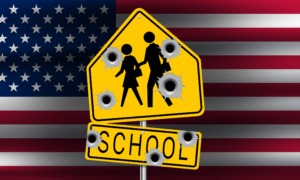
Motortion Films/Shutterstock
.
In the wake of highly publicized and tragic mass shootings at schools, jurisdictions across the country have responded with a flood of expanded school security policies. While much of this policymaking has echoed previous measures, like school hardening, surveillance and policing, some policymakers have focused on preventing targeted violence (where an attacker selects a particular target in advance) by identifying potentially violent actors and intervening to stop them before a violent act occurs. They label this threat assessment.
The expansion of threat assessment as a routine school safety tool has been swift, with little thought given to the ramifications for youth rights.

Rory Doyle
Harold Jordan
Often these reactive policies do little to promote actual safety, while undermining the basic civil rights and civil liberties of students who pose no real threat to the school community, with particularly harsh consequences for students of color and students with disabilities. The broad and unrestricted use of threat assessments will likely undermine the slow progress schools and the justice system have been making in stemming the school-to-prison pipeline.
What is threat assessment anyway?
Threat assessment is promoted as a process for evaluating communicated threats to the school community, within their context, to determine whether threats are likely to be carried out. The goal is to be in a position to take preventative action on true threats without overreacting to normal juvenile venting, joking or personal characteristics common among young people (such as styles of dress, communication, etc.).
Unlike profiling or risk assessment, threat assessment should be triggered by a communication or threatening behavior, not personal characteristics. The reality is quite different. A student’s personal characteristics, or subjective opinions about a student, can serve as the basis for initiating a formal assessment process, which can lead to serious consequences for the student.
For instance, an award-winning investigative report in The Oregonian, “Targeted: A Family and the Quest to Stop the Next School Shooter,” tells the story of an autistic student who was placed into a threat assessment process for an extended period of time largely based on profiling, although he had made no threat. The student eventually dropped out of school.
Blurred lines between behavior and personal characteristics in threat assessment protocols often turn instruments that were designed to assess the danger of actual, communicated threats into attempts to predict future behavior. When threat assessment goes beyond communicated threats in this way, the risk of decisions based on implicit and explicit bias increases dramatically.
Anonymity expands the risks
The risks of these harmful decisions are a growing problem as states move toward mandatory threat assessments. At least 10 states have passed threat assessment laws, five in 2019 alone. Threat assessment is also used in many schools even where state law does not make it mandatory. The U.S. Secret Service recently launched an initiative to promote the widespread use of threat assessment in schools. Schools across the country are trying to determine how to best implement threat assessments, often with limited resources.
Because policymakers, including legislators, promote threat assessment as a tool to prevent school shootings, school leaders are under intense pressure to use threat assessment too broadly and without appropriate guardrails, even when they may have reservations. In many jurisdictions, a threat assessment can be triggered by any report of behavior or concern, even when no explicit threat is made.
The scope and breadth of reported concerns and the resulting investigations becomes all the more troubling as states implement anonymous reporting systems. Pennsylvania’s anonymous reporting program, Safe2Say, received more than 40,000 tips in its first year. Anonymous reports are sometimes used to bully students.
I have observed these issues firsthand. Because of my statewide work on school issues, I was asked to serve on a newly formed threat assessment advisory group in September 2019 by the Pennsylvania Commission on Crime and Delinquency. This group drafted guidelines for school districts on how to implement the June 2019 state law that requires every K-12 public school to have a threat assessment team and process. As in other states, Pennsylvania’s guidelines fail to contain the guardrails to ensure threat assessments are not misused.
To minimize the unintended consequences already being seen across the country, policymakers and school leaders should place restrictions on what can trigger threat assessment and when to involve law enforcement. Importantly, they should incorporate more transparency and oversight protections in the use of threat assessment. There should be public reporting of data on the numbers and characteristics of students who have been assessed, as well as outcomes.
Privacy, equity can take a hit
What’s at stake are violations of student privacy and increased referrals of students to law enforcement when there is no actionable threat, with long-term negative consequences for students.
Threat assessment teams typically include law enforcement, which some states require by law. Assessment protocols can effectively circumvent longstanding privacy laws that restrict the sharing of student records with police except in genuine emergencies or by court order. They thus increase the likelihood of justice system involvement for students, even when there is no actionable threat.
Information may be held indefinitely, inserted into other criminal justice databases accessible to law enforcement and others in the future. The potential uses for such information are endless and potentially catastrophic. Will the threat label follow students, even when they cause no harm? Can information or tips gathered in the threat assessment process be used for immigration enforcement purposes?
Although limited data is available, it is clear that students of color, students with disabilities and other vulnerable populations are being disproportionately impacted. These disparities echo trends in school discipline and arrests in schools.
Currently available data indicates that black students are disproportionately referred for threat assessments. Similarly, students with disabilities are substantially more likely to be referred than other students. Groups of students may be ostracized, stigmatized and profiled without any explicit or believable threat.
A recent investigative report by Searchlight New Mexico, “Who’s the Threat?” found that the Albuquerque, N.M., school district conducted 834 threat assessments during the 2018-19 school year. Special education students, while 18% of students, were the subject of 56% of all threat assessments. Similarly, black students, who comprised only 2.6% of students, accounted for 9.6% of the students assessed.
While threat assessment was developed to provide a roadmap to isolate true threats that need attention, the trends in implementation illustrate that our schools risk the opposite. As the number of threat assessments increase and the number of students labeled as “threats” grows, it will become harder still to isolate the actual true threat and to provide supportive interventions.
Likewise, the research on averted shootings is clear: Students are more likely to come forward with information about genuine safety threats when they feel respected by the adults and trust them to be fair. Growing supportive school communities prevents violence. Ostracizing students who stand out or misspeak does not create such a community.
A just approach
Threat assessment, to be effective and fair, must: be restricted to situations in which a clear threat is communicated; be transparently assessed for patterns of inequity (by race, disability, gender, etc.); and limit police involvement — including unwarranted access to student records — to emergency situations where there is an imminent threat to the school community, and school staff determine that a referral to law enforcement is needed.
The alternative is a school community where there is bias, unfair punishment and mistrust between students and adults who administer school discipline and intervention processes — a school community where students may hesitate before asking for help or reporting concerns.
Harold Jordan is senior policy advocate at the American Civil Liberties Union of Pennsylvania. He can be reached at hjordan@aclupa.org.































